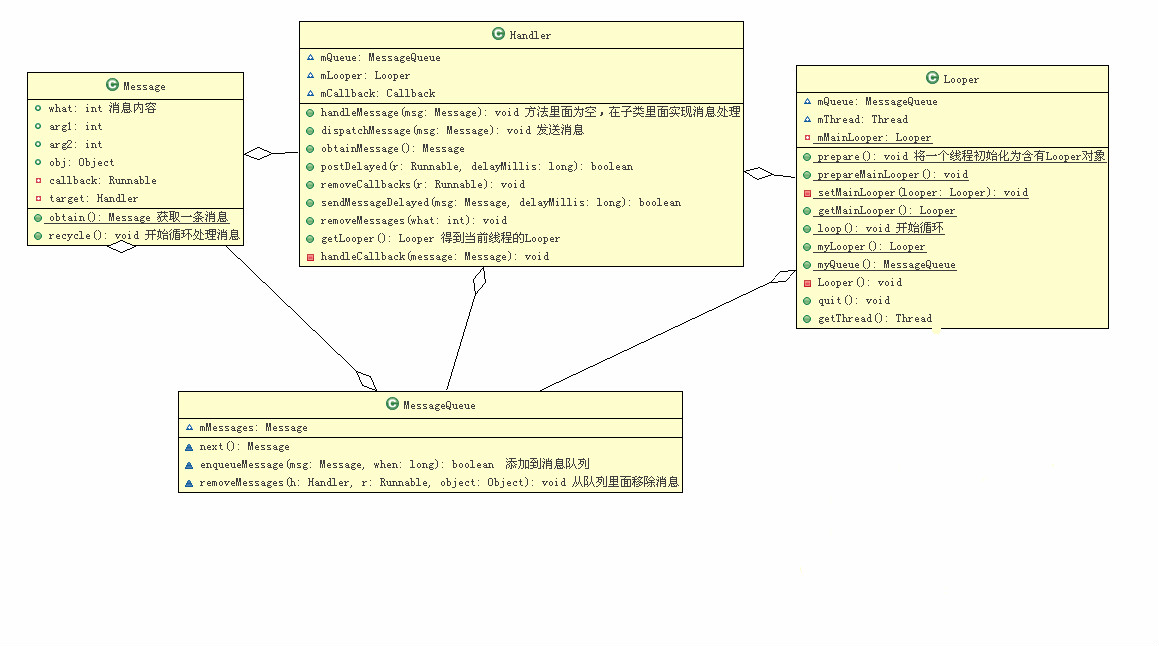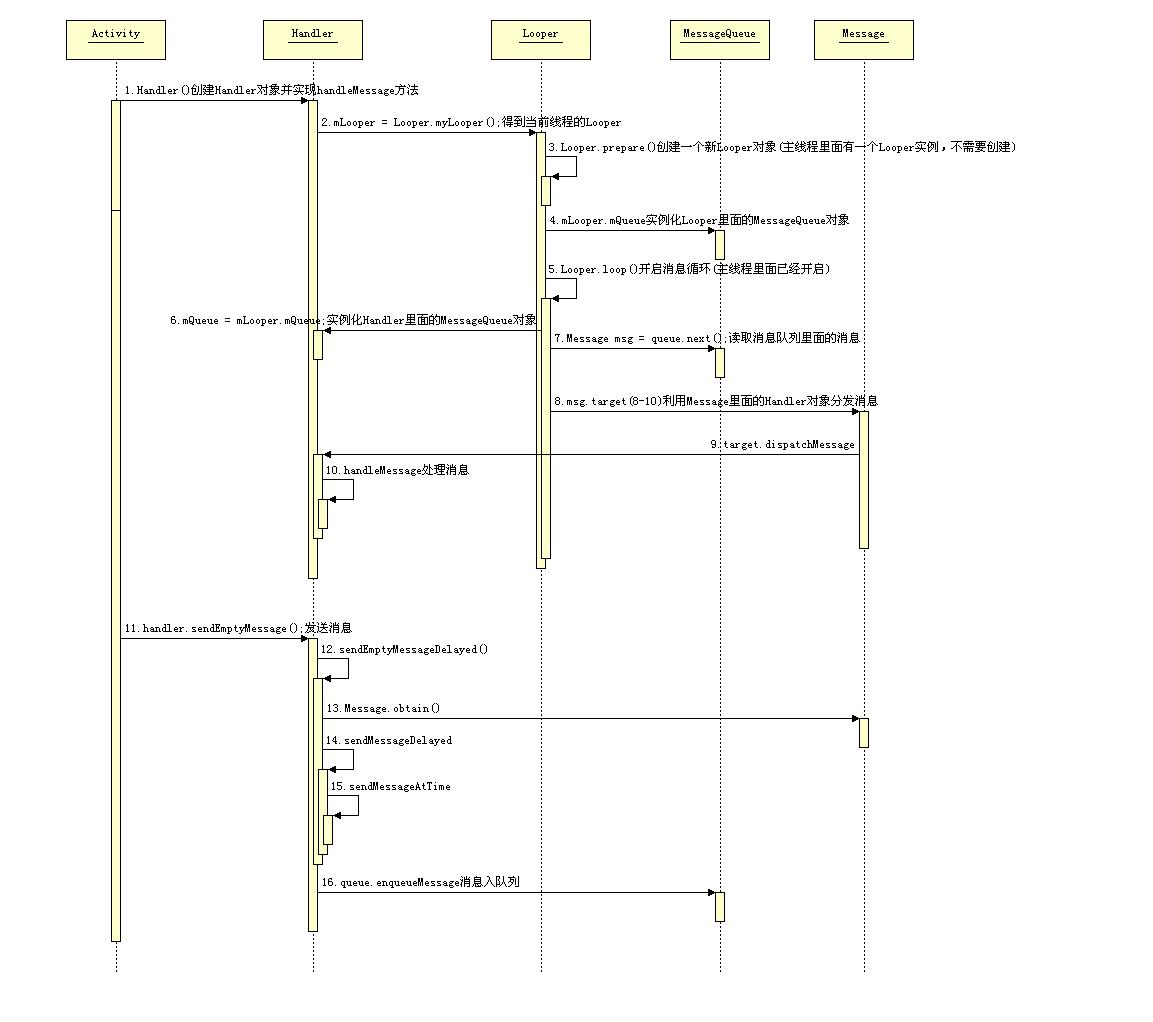承接上一篇Handler系列一,上篇主要总结了Handler如何通信,这篇来介绍Handler怎么通信。
- Handler的通信机制
- Handler,Looper,MessageQueue如何关联
Handler 通信机制

- 创建Handler,并采用当前线程的Looper创建消息循环系统;
- Handler通过sendMessage(Message)或Post(Runnable)发送消息,调用enqueueMessage把消息插入到消息链表中;
- Looper循环检测消息队列中的消息,若有消息则取出该消息,并调用该消息持有的handler的dispatchMessage方法,回调到创建Handler线程中重写的handleMessage里执行。
Handler如何关联Looper、MessageQueue
Handler及其关联的类图
以上类图可以快速帮助我们理清Handler与Looper、MessageQueue的关系,以下从源码的角度慢慢分析:
1、Handler 发送消息
上一段很熟悉的代码:
1 | Message msg =Message.obtain(); //从全局池中返回一个message实例,避免多次创建message(如new Message) |
从sendMessageQueue开始追踪,函数调用关系:sendMessage -> sendMessageDelayed ->sendMessageAtTime,在sendMessageAtTime中,携带者传来的message与Handler的mQueue一起通过enqueueMessage进入队列了。
对于postRunnable而言,通过post投递该runnable,调用getPostMessage,通过该runnable构造一个message,再通过 sendMessageDelayed投递,接下来和sendMessage的流程一样了。
2、消息入队列
在enqueueMessage中,通过MessageQueue入队列,并为该message的target赋值为当前的handler对象,记住msg.target很重要,之后Looper取出该消息时,还需要由msg.target.dispatchMessage回调到该handler中处理消息。
1 | private boolean enqueueMessage(MessageQueue queue, Message msg, long uptimeMillis) { |
在MessageQueue中,由Message的消息链表进行入队列
1 | boolean enqueueMessage(Message msg, long when) { |
3、Looper 处理消息
再说处理消息之前,先看Looper是如何构建与获取的:
构造Looper时,构建消息循环队列,并获取当前线程
1
2
3private Looper(boolean quitAllowed) {
mQueue = new MessageQueue(quitAllowed);
mThread = Thread.currentThread();}但该函数是私有的,外界不能直接构造一个Looper,而是通过Looper.prepare来构造的:
public static void prepare() {
1
prepare(true);
} private static void prepare(boolean quitAllowed) {1
2
3
4if (sThreadLocal.get() != null) {
throw new RuntimeException("Only one Looper may be created per thread");
}
sThreadLocal.set(new Looper(quitAllowed));}这里创建Looper,并把Looper对象保存在sThreadLocal中,那sThreadLocal是什么呢?
static final ThreadLocal
sThreadLocal = new ThreadLocal (); 它是一个保存Looper的TheadLocal实例,而ThreadLocal是线程私有的数据存储类,可以来保存线程的Looper对象,这样Handler就可以通过ThreadLocal来保存于获取Looper对象了。
TheadLocal 如何保存与获取Looper?
1
2
3
4
5
6
7
8public void set(T value) {
Thread currentThread = Thread.currentThread();
Values values = values(currentThread);
if (values == null) {
values = initializeValues(currentThread);
}
values.put(this, value);
}public T get() {
1
2
3
4
5
6
7
8
9
10
11
12
13
14
15// Optimized for the fast path.
Thread currentThread = Thread.currentThread();
Values values = values(currentThread);
if (values != null) {
Object[] table = values.table;
int index = hash & values.mask;
if (this.reference == table[index]) {
return (T) table[index + 1];
}
} else {
values = initializeValues(currentThread);
}
return (T) values.getAfterMiss(this);
}在 set 中都是通过
values.put保存当前线程的 Looper 实例,通过values.getAfterMiss(this)获取,其中put和getAfterMiss都有key和value,都是由Value对象的table数组保存的,那么在table数组里怎么存的呢?table[index] = key.reference;
1
table[index + 1] = value;
很显然在数组中,前一个保存着ThreadLocal对象引用的索引,后一个存储传入的Looper实例。
接下来看Looper在loop中如何处理消息
在loop中,一个循环,通过next取出MessageQueue中的消息
- 若取出的消息为null,则结束循环,返回。
- 设置消息为空,可以通过MessageQueue的quit和quitSafely方法通知消息队列退出。
- 若取出的消息不为空,则通过msg.target.dispatchMessage回调到handler中去。
1 | public static void loop() { |
4、handler处理消息
Looper把消息回调到handler的dispatchMessage中进行消息处理:
- 若该消息有callback,即通过Post(Runnable)的方式投递消息,因为在投递
runnable时,把runnable对象赋值给了message的callback。 - 若handler的mCallback不为空,则交由通过
callback创建handler方式去处理。 否则,由最常见创建handler对象的方式,在重写handlerMessage中处理。
1
2
3
4
5
6
7
8
9
10
11
12public void dispatchMessage(Message msg) {
if (msg.callback != null) {
handleCallback(msg);
} else {
if (mCallback != null) {
if (mCallback.handleMessage(msg)) {
return;
}
}
handleMessage(msg);
}
}
总结
以一个时序图来总结handler的消息机制,包含上述如何关联Looper和MessageQueue的过程。
Handler-Looper-MessageQueue时序图
